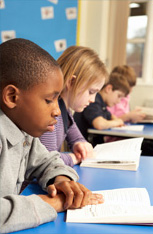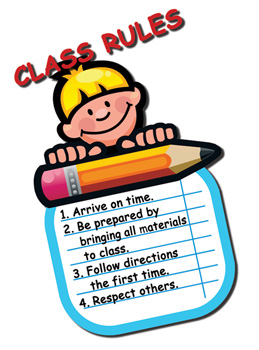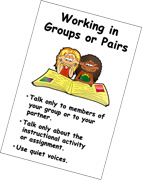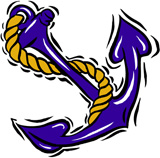How do teachers prepare their students and their classrooms for differentiated instruction?
Page 11: Employ Effective Behavior Management
 To effectively differentiate instruction, teachers must establish rules and procedures. Rules (or expectations) identify, define, and operationalize the concepts of acceptable behavior. They also provide guidelines for students to monitor their own behavior, and they remind and motivate students to meet certain behavioral standards. Procedures explain the accepted process for carrying out a specific activity.
To effectively differentiate instruction, teachers must establish rules and procedures. Rules (or expectations) identify, define, and operationalize the concepts of acceptable behavior. They also provide guidelines for students to monitor their own behavior, and they remind and motivate students to meet certain behavioral standards. Procedures explain the accepted process for carrying out a specific activity.
When they establish rules and procedures for a differentiated classroom, teachers can begin by instituting a good classroom behavior management system. These rules and procedures for appropriate behavior should apply to all classroom activities. Next, teachers must establish specific procedures that address considerations related to differentiating instruction. For these procedures to be effective, teachers should:
Classroom Behavior Management System
 It is important for teachers to establish clear expectations. Teachers who establish and maintain effective classroom rules are more likely to prevent potential behavior problems and disruption during instruction. It is essential that these rules:
It is important for teachers to establish clear expectations. Teachers who establish and maintain effective classroom rules are more likely to prevent potential behavior problems and disruption during instruction. It is essential that these rules:
- Are positively stated
- Use simple, specific terms
- Are measurable and observable
- Clearly convey expected behavior
To learn more about developing a classwide behavior management plan, view the following IRIS Modules:
- Discuss why, where, and when the procedure is needed and how it should be implemented.
- Explicitly teach and model the procedure.
- Create opportunities for students to practice the procedure until they thoroughly understand what is expected of them, making sure to provide feedback on correct and incorrect implementation of the procedure.
- Continue to monitor students as they implement the procedure independently and provide corrective feedback as needed.
For Your Information
When making decisions about the procedures for a differentiated classroom, teachers should allow their students to participate in the decision-making process. Through their involvement in this process, students come to accept more responsibility for their behavior.
Michelle Giddens discusses why it is important to establish rules and procedures in a differentiated classroom (time: 1:34).

Michelle Giddens, MEd
Assistant Principal Intern,Former Third-Grade Teacher
Sarasota, FL
Transcript: Michelle Giddens, MEd
I think there’s fewer behavior problems in a class where a teacher is differentiating instruction, just because students are working at their readiness level. They’re being challenged appropriately, and the teacher can recognize when the student needs a little bit more support or if a student needs enrichments. I feel like, when a teacher is developing the rules and procedures for differentiation, we’re really setting those expectations. There’s so much fluidity between the students that kids will be coming over in groups, other kids will be working with another group of students, other times students will be working independently, so there’s so much movement going on that if you don’t have these rules and procedures and your expectations in place for students I can see where that would be a real challenge for a teacher. So I feel like this needs to be the first thing that is developed in the classroom, if the students are successful. Not to mention the fact that when I’m working with a reading group of students and I need to be focused with them and working with them on certain skills, other students need to be focused independently. So having a checklist in place or some kind of a rubric for them to use to be accountable for the work that they’re responsible for and having that ownership is key for this type of a setting in the classroom as well. If you don’t have those expectations and those routines in place, I can see where it would be more challenging for a teacher, because you are going to have so many different things happening.
Teachers should consider developing procedures for several common activities that often occur in a differentiated classroom. By doing so, teachers can maintain an orderly classroom in which students are able to learn effectively and time is used wisely. Following are several areas to consider when developing procedures.
Working in Small Groups or Pairs
 By developing rules and procedures for working in groups, teachers create an environment in which students are able to work effectively without supervision. This allows teachers to focus their attention on the instructional needs of individuals or small groups. It is important to remember that students may not know how to work effectively in groups and will have to be explicitly taught how to do so. Learning to work in groups or pairs is most effectively accomplished when students are engaged in a meaningful task. One fun way to get students accustomed to interacting with each other in a positive way is to allow them to play instructional board games.
By developing rules and procedures for working in groups, teachers create an environment in which students are able to work effectively without supervision. This allows teachers to focus their attention on the instructional needs of individuals or small groups. It is important to remember that students may not know how to work effectively in groups and will have to be explicitly taught how to do so. Learning to work in groups or pairs is most effectively accomplished when students are engaged in a meaningful task. One fun way to get students accustomed to interacting with each other in a positive way is to allow them to play instructional board games.
Maintaining Appropriate Noise Levels

Because students in a differentiated classroom often work in small groups or pairs, teachers should establish rules about talking and appropriate noise level. When discussing these rules with the students, it is important for teachers to define and demonstrate acceptable noise levels for different activities. For example, teachers might expect their students to work silently during independent seatwork but allow quiet talking during paired or small-group activities.
- Use a stoplight where the green light indicates appropriate noise level, yellow is getting too loud, and red is too loud.
- Flick the lights off and on.
- Ask the students to hold up their hands and fold their fingers down as the teacher counts backwards from five to one, ending with their index finger in front of their lips.
- Create a noise meter to signal the acceptable noise level (e.g., silence, six-inch voice, work voice) for a given activity.
- Nominate a student in each small group to monitor noise.
For Your Information
Some students find it difficult to work on assignments when other students are talking. For these students, teachers can supply headphones or earplugs to reduce or eliminate noise.
Transitioning Between Activities
- Time student transitions and then challenge them to beat their best time. (Teachers can do this until students are moving quickly without disruptions.)
- Organize materials so that students can retrieve them quickly or designate one student per group to obtain materials.
- Cue students prior to transitions (e.g., “In five minutes, we will move to our next activity.”).
- Tell students where they will be and what group they will be in (e.g., floor plan, grouping charts) for the next activity.

Acquiring Help

In a differentiated classroom, teachers sometimes monitor their students as they work in pairs or groups and sometimes they work with an individual or small group of students. In such instances, teachers are unavailable to answer questions. To minimize interruptions, teachers should plan for how students can get help and should encourage students to become independent learners.
- Consult the “Expert of the Day,” one or more students designated by the teacher to clarify directions or answer questions about the classwork on a given day.
- Request help from a classmate.
- Relinquish a “question chip.” The teacher distributes one or two poker chips or tokens to each student at the beginning of the day or the beginning of class. Each time the student asks the teacher a question, he or she must relinquish a poker chip. Once his or her chips are gone, the student cannot ask the teacher another question.
- Place a placard with a question mark on the desk to signal to the teacher that help is needed.
Group Strategy
One strategy that groups can use for signaling that they need the teachers help is to use colored stacking cups.
![]()
![]()
![]()
Managing Time
 Because students work at different rates, some will complete a task before the end of the allotted time. To keep these students productively engaged, teachers should have additional activities available for them to work on. Often referred to as anchor activities, these tasks address important learning goals and are engaging for students. To minimize disruptions and wasted classroom time, teachers should have procedures in place for students to begin anchor activities as soon as they complete their assigned task.
Because students work at different rates, some will complete a task before the end of the allotted time. To keep these students productively engaged, teachers should have additional activities available for them to work on. Often referred to as anchor activities, these tasks address important learning goals and are engaging for students. To minimize disruptions and wasted classroom time, teachers should have procedures in place for students to begin anchor activities as soon as they complete their assigned task.

- Read silently
- Write in my journal
- Review vocabulary for the next assignment
- Work on an activity in the reading center
- Work on a reading activity on the computer
- Choose a character from the reading assignment and write a letter to him or her
- Rewrite a recent reading assignment as a comic strip
- Write a song or rap to summarize a recent reading assignment
Getting and Turning in Materials
To maximize instructional time and minimize disruptions, teachers need to develop procedures for students to efficiently obtain and turn in materials. These procedures might vary depending on the types of instructional activities the students are engaged in or the grouping methods being used.
| Instructional Activity | Procedures |
| Whole-group instruction |
|
| Small-group instruction |
|
| Learning centers |
|
| Paired instruction |
|
Tip
To prevent students from watching the clock and stopping work well before the class period ends, it is helpful for teachers to signal to let the students know when they should start putting away their work and supplies.
[D]eveloping a system through which students learn to play a large role in managing themselves, their work, and their success is not an ideal but a necessity.